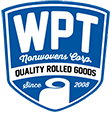Through air bonded nonwovens are used in the development of durable end use products including bedding, furniture and carpet backings, as well as disposable products such as hygiene wipes and fabric softener sheets.
Featuring advantages such as high tensile strength and versatility, through air bonded nonwovens also offer loft, bulk, absorbency and thickness, as well as lower weights. On the production side, through air bonded nonwovens are processed without the use of chemical binders, which means a much safer production process and working environment. Since no binder preparation is required, through air bonded nonwoven is also more efficiency and cost effective to produce.
For some time, through air bonding has been replacing the long-used process of spray latex bonding. Through air bonding is superior to spray bonding, which only sprays the outer layers of the web. The through air bonding process bonds thicker webs uniformly throughout the core. Since through air bonding relies on hot air instead of sprays, resins, and solvents, it is also naturally more environmentally friendly and hygienic.
Through air bonding is the only thermal bonding process that allows the entire product to be exposed to a uniform temperature. The process involves wrapping a nonwoven web around a drum, through which hot air passes to heat or bond the nonwoven material. Air through dryers will either thermally bond or heat set nonwovens formed using a variety of technologies such as carding, airlaying, thermal bonding, spunbonding, wetlaying or spunlacing. For the production of spunlaced or wetlaid nonwoven, air through dryers and ovens can eliminate moisture to produce a stiffer material. Perforated conveyor belts can used to produce bulkier materials.
Because through air bonded nonwovens are so highly versatile, they are steadily replacing other nonwoven technologies. WPT uses extensive carding methods in their through air bonding process to ensure a uniform web formation. Our double bled line allows us to produce a gradient structure ideal for superior dust holding capabilities as well as highly effective strike through and rewet performance.

